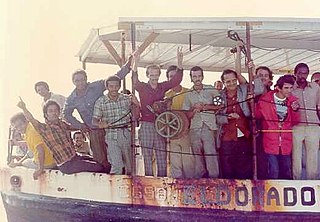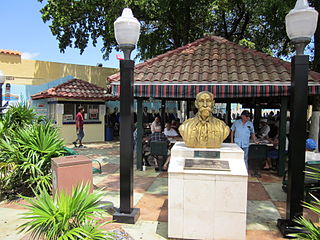Related Research Articles

Úrsula Hilaria Celia de la Caridad Cruz Alfonso, known as Celia Cruz, was a Cuban singer and one of the most popular Latin artists of the 20th century. Cruz rose to fame in Cuba during the 1950s as a singer of guarachas, earning the nickname "La Guarachera de Cuba". In the following decades, she became known internationally as the "Queen of Salsa" due to her contributions to Latin music.

The Mariel boatlift was a mass emigration of Cubans who traveled from Cuba's Mariel Harbor to the United States between 15 April and 31 October 1980. The term "Marielito" is used to refer to these refugees in both Spanish and English. While the exodus was triggered by a sharp downturn in the Cuban economy, it followed on the heels of generations of Cubans who had immigrated to the United States in the preceding decades.

Little Havana is a neighborhood of Miami, Florida, United States. Home to many Cuban exiles, as well as many immigrants from Central and South America, Little Havana is named after Havana, the capital and largest city in Cuba.

El Tropicana Night Club in Havana, Cuba located in a lush, six-acre estate tropical garden opened on December 30, 1939 at the Villa Mina in Marianao. It is located next door to the old Colegio de Belén, presently, the Instituto Técnico Militar.

Amelia Peláez del Casal was an important Cuban painter of the Avant-garde generation.
Ofelia Fox, born Ofelia Suárez in Havana, Cuba, was a poet, lecturer and radio personality whose life as the wife of a Havana nightclub owner was chronicled in the book Tropicana Nights: the Life and Times of the Legendary Cuban Nightclub. .
The Getty Foundation, based in Los Angeles, California at the Getty Center, awards grants for "the understanding and preservation of the visual arts". In the past, it funded the Getty Leadership Institute for "current and future museum leaders", which is now at Claremont Graduate University. Its budget for 2006–07 was $27.8 million. It is part of the J. Paul Getty Trust.

Architectural Resources Group is a firm that was founded in 1980 by Bruce Judd and Steve Farneth in San Francisco, CA. It began by providing professional services in the fields of architecture and urban planning with particular expertise in the area of historic preservation. In 2000, David Wessel, a Principal of ARG, founded a separate conservation-contracting division, ARG Conservation Services which operates under the same roof as ARG. By 2005, the firm had expanded to a full-service architecture firm with 50+ employees. ARG also opened offices in Pasadena serving Southern California, and Portland, Oregon, serving the Pacific Northwest.

Malena Burke is a well-known Cuban singer now living in Miami.

Belkis Ayón was a Cuban printmaker who specialized in the technique of collography. Ayón created large, highly detailed allegorical collagraphs based on Abakuá, a secret, all-male Afro-Cuban society. Her work is often in black and white, consisting of ghost-white figures with oblong heads and empty, almond-shaped eyes, set against dark, patterned backgrounds.

Rita Aurelia Fulcida Montaner y Facenda, known as Rita Montaner, was a Cuban singer, pianist and actress. In Cuban parlance, she was a vedette, and was well known in Mexico City, Paris, Miami and New York, where she performed, filmed and recorded on numerous occasions. She was one of Cuba's most popular artists between the late 1920s and 1950s, renowned as Rita de Cuba. Though classically trained as a soprano for zarzuelas, her mark was made as a singer of Afro-Cuban salon songs including "The Peanut Vendor" and "Siboney".

José Parlá, is a Brooklyn-based contemporary artist whose work has been described as "lying between the boundary of abstraction and calligraphy."

Carlos Enrique Prado is a contemporary Cuban artist. He has worked in various artistic media such as sculpture, ceramics, drawing, digital art, performance, installations and interventions. Between 2002 and 2012, he was a professor at ISA University of Arts of Cuba, where he was also the head of the sculpture program. He currently lives and works in Miami, Florida. He teaches ceramics and sculpture at the University of Miami, Coral Gables, Florida. He recently completed a major public sculpture, the Ronald Reagan Equestrian Monument, located in Tropical Park, Miami, commissioned by Miami-Dade County's Art in Public Places program.

Ricardo Porro Hidalgo was a Cuban-born architect. He graduated in architecture from the Universidad de la Habana in 1949 and built this year his first project Villa Armenteros in Havana, following which he spent two years in post-graduate studies at the Institute of Urbanism at the Sorbonne.
Armando de Sequeira Romeu is a Cuban musical director, composer, arranger, violinist, drummer and bassist. He is best known for his association with the Orquesta Cubana de Música Moderna, an Afro-Cuban jazz ensemble which spawned various successful groups such as Irakere.

Victoria Blyth Hill was an American art conservator who lived and worked in the Venice area of Los Angeles. She retired from the Los Angeles County Museum of Art as the Director, Conservation Center in June 2005 when she was honored with an appointment as Senior Conservator Emeritus at the Los Angeles County Museum of Art (LACMA). Subsequently she worked with private clients, including artists, individuals, and museums, and operated an art conservation studio near her home. She was a past president of the Western Association for Art Conservation (1979). Blyth-Hill was elected Fellow of the American Institute for Conservation of Historic and Artistic Works (AIC) in 1990.
The conservation and restoration of outdoor murals is the process of caring for and maintaining murals, and includes documentation, examination, research, and treatment to insure their long-term viability, when desired.
Manolo Álvarez Mera(néManuel Ernesto Álvarez-Mera 7 November 1923 Havana, Cuba – 16 October 1986 New York City) was a Cuban-born tenor who flourished as a bel canto during the late 1940s and 1950s. Despite having an operatic caliber voice, he gained popularity singing in operettas, musical reviews, radio, television, vaudeville, and major night clubs in Cuba, New York, and Latin America. He became a Cuban exile in 1960 after the Cuban Revolution.

The Sans Souci was a nightclub within a natural environment and located seven miles outside of Havana. It had a restaurant and floor shows nightly that attracted a great number of tourists. Its greatest profits came from an amusement arcade operating in a small room next door to the Sans Souci that was not advertised since there was no official license for its exploitation.

The Colegio de Belén located between 45th and 66th streets – situated next door to the Tropicana nightclub – in Marianao, Havana, was designed in 1925 by the architect Leonardo Morales y Pedroso and his brother the engineer Luis Morales y Pedroso of the firm Morales y Compañía Arquitectos.
References
- ↑ Jewish Journal: "So many authors, so little time" by Naomi Pfefferman September 14, 2006
- 1 2 3 4 5 6 7 8 9 10 11 12 "About Me". rosalowinger.com. Retrieved July 17, 2011.
- ↑ "Architecture and Design at MOLAA". molaa.com. April 15, 2010. Retrieved July 17, 2011.
- 1 2 "ROSA LOWINGER". aarome.org/. Retrieved July 17, 2011.
- ↑ Pool, Bob (July 16, 1996). "Statues Under Siege". Los Angeles Times . Retrieved July 17, 2011.
- ↑ "Annual Meeting / Conference 2006". hawaiimuseums.org. Archived from the original on October 6, 2011. Retrieved July 17, 2011.
- ↑ "In Haiti: Rescuing Art Amid the Rubble". WNYC.org. Archived from the original on January 19, 2012. Retrieved July 17, 2011.
- ↑ "Topicana Nights". CigarAficionado.com. Retrieved July 17, 2011.
- ↑ "Cafe L.A.: Rosa Lowinger and Tropicana Nights". KCRW.com. Retrieved July 17, 2011.
- ↑ Moruzzi, Peter (2008). Havana Before Castro: When Cuba was a Tropical Playground. Layton, Utah.: Gibbs Smith. p. 8. ISBN 978-1-4236-0367-2.
- ↑ English, TJ (2008). Havana Nocturne: How the Mob Owned Cuba and Then Lost It to the Revolution . New York City: HarperCollins. pp. 331. ISBN 978-0-06-114771-5.
- ↑ Created by Kosh, Susan Shearer, John J. Flynn (March 26, 2006). "Godfathers of Havana". Declassified. Season 1. Episode 1.13. The History Channel . Retrieved July 19, 2011.
- ↑ "In Haiti: Rescuing Art Amid the Rubble". RosaLowinger.com. Retrieved July 17, 2011.
- ↑ Gussow, Mel (April 2, 1991). "Review/Theater; An Evening of One-Acts on Rules of Relationships". The New York Times . Retrieved July 17, 2011.
- ↑ "In the hands of Cuban artist Kcho, boats, docks, and oars become potent symbols of migration". artnews.com. Archived from the original on November 19, 2010. Retrieved July 20, 2011.
- ↑ "The Object as Protagonist: an Interview with Los Carpinteros Alexandre Arrechea, Marco Castillo, and Dagoberto Rodriguez". loscarpinteros.net. Archived from the original on November 24, 2010. Retrieved July 20, 2011.
- ↑ "The Interview". eljardindeladesconfianza.com. Retrieved July 20, 2011.
- ↑ "Journal Information". c-monster.net. Retrieved July 17, 2011.
- 1 2 "Ask the Art Nurse". c-monster.net. Retrieved July 17, 2011.
- ↑ "NEW PROJECTS". elwoodandassociates.com. Retrieved July 17, 2011.
- ↑ "History of Transportation" Mural". laconservancy.org. Retrieved July 17, 2011.
- ↑ "Board of Directors". fundacionamistad.org. Archived from the original on March 13, 2012. Retrieved July 17, 2011.
- ↑ "Getty Announces $1.4 Million in Grants for Architectural Preservation of Historic Buildings and Sites in Los Angeles County". getty.edu. Retrieved July 17, 2011.
- 1 2 Dickinson, J Ron (March 2010). "Portal of the Folded Wings – A Shrine to Aviation". airportjournals.com. Archived from the original on April 22, 2011. Retrieved July 17, 2011.